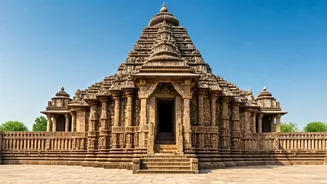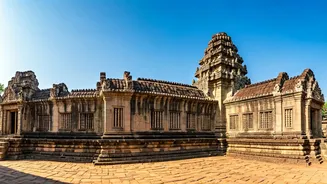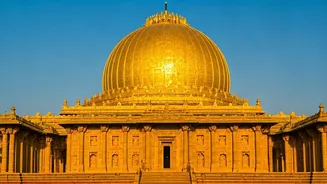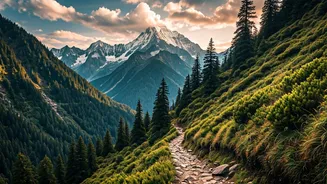Konark Sun Temple
The Konark Sun Temple in Odisha, a UNESCO World Heritage site, is a magnificent example of 13th-century architecture. Built by King Narasimhadeva I, the
temple is designed as a colossal chariot of the sun god, Surya, with twelve pairs of intricately carved wheels. These wheels serve as sundials, demonstrating the advanced astronomical knowledge of the time. The temple's structure includes a main sanctum, a dance hall, and a jagamohana (audience hall), all adorned with detailed sculptures depicting daily life, mythical creatures, and religious figures. The temple's diminishing size reflects the challenges it faced over centuries from the elements and vandalism. Konark is not just a place of worship, but a symbol of India's artistic prowess and historical significance, attracting visitors worldwide with its grandeur and historical echoes.
Modhera Sun Temple
Gujarat's Modhera Sun Temple, constructed in the early 11th century by King Bhima I of the Solanki dynasty, stands as another jewel of Indian temple architecture. Unlike Konark, the main structure is missing due to earthquake damage, but its remaining features still provide a clear understanding of its original splendor. The temple is built in the Maru-Gurjara style, showcasing elaborate carvings and geometric patterns. It features a stepped tank called the 'Surya Kund' or 'Ramakunda,' where devotees would cleanse before prayer. The temple is known for its exquisite carvings of deities, scenes from the Ramayana and Mahabharata, and representations of solar symbolism. Today, the Modhera Sun Temple remains an essential historical site, demonstrating the architectural brilliance and spiritual beliefs of the Solanki era.
Martand Sun Temple
The Martand Sun Temple, located in Kashmir, presents a unique blend of architecture, showcasing influences of Gandhara, Gupta, and Chinese styles. Constructed by King Lalitaditya Muktapida in the 8th century, the temple was dedicated to Surya. It once comprised a central shrine, subsidiary shrines, and a surrounding courtyard. The temple was built using a combination of stone and lime mortar, with detailed carvings on the walls and pillars depicting various aspects of life, including religious figures and detailed scenes. Despite being destroyed in the 15th century by invaders, the temple's ruins are still impressive, allowing visitors to visualize its grand scale and architectural magnificence. The Martand Sun Temple showcases the rich cultural interactions and artistic excellence that once flourished in the region.
Sun Temple, Deo
The Deo Sun Temple, located in Bihar, provides a distinct perspective on solar worship in India. Built during the 8th-century, it's dedicated to the sun god, Surya, and is significant due to its unique architectural design. The structure features a large rectangular tank, the 'Surya Kund', similar to the one at Modhera, which devotees used for ritual cleansing before entering the temple. The temple's architecture, including intricate carvings on the walls and entrance, highlights the artistry and craftsmanship of the period. Though lacking the grandeur of Konark or the historical significance of Martand, the Deo Sun Temple continues to be a crucial religious spot for devotees. It celebrates the legacy of Surya, the sun god, and showcases an important aspect of Bihar's rich cultural heritage, drawing pilgrims and history lovers.
Multan Sun Temple
Although the Multan Sun Temple, now in Pakistan, is not currently accessible, its historical significance and legacy are important to this topic. Once a major religious site, the temple was known for its golden idol of Surya. In its prime, the temple was a centre for pilgrimage, drawing devotees from across the Indian subcontinent. The temple, mentioned in various historical texts, had a significant impact on religious and economic activities in the area. Its wealth and prestige made it a target for invaders. Despite the destruction, its legendary existence remains part of the narrative of solar worship in the Indian subcontinent. It serves as a reminder of the rich history of shared cultural heritage, highlighting the diversity and influence of ancient religious sites.















